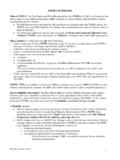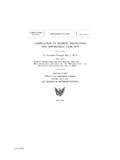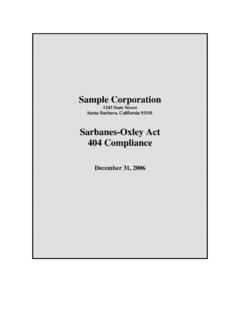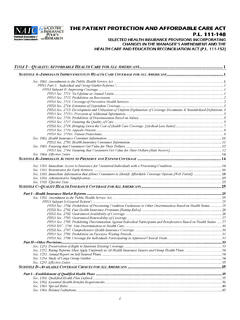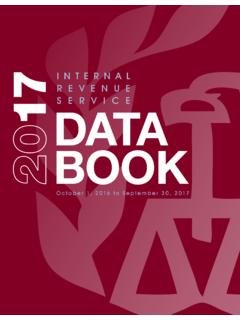Transcription of worker classification pamphlet - irs.gov
1 PRESENT LAW AND BACKGROUND RELATING TO worker classification FOR FEDERAL TAX PURPOSES Scheduled for a Public Hearing before the SUBCOMMITTEE ON SELECT REVENUE MEASURES and the SUBCOMMITTEE ON INCOME SECURITY AND FAMILY SUPPORT of the HOUSE COMMITTEE ON WAYS AND MEANS on May 8, 2007 Prepared by the Staff of the JOINT COMMITTEE ON TAXATION May 7, 2007 JCX-26-07 i CONTENTS Page INTRODUCTION .. 1 I. worker classification RULES .. 2 A. Present 2 B. Reasons for Misclassification of Workers .. 8 II. EFFECT OF MISCLASSIFICATION ON FEDERAL 10 III. ALTERNATIVE METHODS OF CLASSIFYING 12 A. General Issues .. 12 B. Issues Under Specific Proposals .. 14 1 INTRODUCTION The Subcommittee on Income Security and Family Support and the Subcommittee on Select Revenue Measures of the House Committee on Ways and Means have scheduled a joint public hearing for Tuesday, May 8, 2007, on the effects of misclassifying workers as independent contractors.
2 This document,1 prepared by the staff of the Joint Committee on Taxation, provides a description of present law and background relating to worker classification for Federal tax purposes. 1 This document may be cited as follows: Joint Committee on Taxation, Present Law and Background Relating to worker classification for Federal Tax Purposes (JCX-26-07), May 7, 2007. This publication is also available on the web at 2 I. worker classification RULES A. Present Law In general Significant tax consequences result from the classification of a worker as an employee or independent contractor. These consequences relate to withholding and employment tax requirements, as well as the ability to exclude certain types of compensation from income or take tax deductions for certain expenses. Some consequences favor employee status, while others favor independent contractor status. For example, an employee may exclude from gross income employer-provided benefits such as pension, health, and group-term life insurance benefits.
3 On the other hand, an independent contractor can establish his or her own pension plan and deduct contributions to the plan. An independent contractor also has greater ability to deduct work-related expenses. Under present law, the determination of whether a worker is an employee or an independent contractor is generally made under a facts and circumstances test that seeks to determine whether the worker is subject to the control of the service recipient, not only as to the nature of the work performed, but the circumstances under which it is performed. Under a special safe harbor rule (sec. 530 of the Revenue Act of 1978), a service recipient may treat a worker as an independent contractor for employment tax purposes even though the worker is in fact an employee if the service recipient has a reasonable basis for treating the worker as an independent contractor and certain other requirements are met. In some cases, the treatment of a worker as an employee or independent contractor is specified by statute.
4 Significant tax consequences also result if a worker was misclassified and is subsequently reclassified, , as a result of an audit. For the service recipient, such consequences may include liability for withholding taxes for a number of years, interest and penalties, and potential disqualification of employee benefit plans. For the worker , such consequences may include liability for self-employment taxes and denial of certain business-related deductions. Common-law test In general, the determination of whether an employer-employee relationship exists for Federal tax purposes is made under a common-law test that has been incorporated into specific provisions of the Internal Revenue Code (the Code ) or that is required to be used pursuant to Treasury regulations or case law. For example, section 3121(d)(2)2 (which defines terms for purposes of the Social Security taxes that apply to wages paid to an employee) generally defines the term employee to include any individual who, under the usual common law rules applicable in determining the employer-employee relationship, has the status of an employee.
5 By contrast, section 3401 (which defines terms for purposes of an employer s Federal income tax withholding obligation with respect to wages paid to an employee) does not define the term employee. However, regulations issued under section 3401 incorporate the common-law test. 2 Except as otherwise indicated, all references to sections are to sections of the Code. 3 The regulations provide that an employer-employee relationship generally exists if the person contracting for services has the right to control not only the result of the services, but also the means by which that result is accomplished. In other words, an employer-employee relationship generally exists if the person providing the services is subject to the will and control of the employer not only as to what shall be done but how it shall be done. 3 Under the regulations, it is not necessary that the employer actually control the manner in which the services are performed, rather it is sufficient that the employer have a right to Whether the requisite control exists is determined based on all the relevant facts and circumstances.
6 Over the years courts have identified on a case-by-case basis various facts or factors that are relevant in determining whether an employer-employee relationship exists. In 1987, based on an examination of cases and rulings, the Internal Revenue Service ( IRS ) developed a list of 20 factors that may be examined in determining whether an employer-employee relationship The degree of importance of each factor varies depending on the occupation and the factual context in which the services are performed; factors other than the listed 20 factors may also be relevant. The 20 factors identified by the IRS are as follows: 1. Instructions: If the person for whom the services are performed has the right to require compliance with instructions, this indicates employee status. 2. Training: worker training ( , by requiring attendance at training sessions) indicates that the person for whom services are performed wants the services performed in a particular manner (which indicates employee status).
7 3. Integration: Integration of the worker s services into the business operations of the person for whom services are performed is an indication of employee status. 4. Services rendered personally: If the services are required to be performed personally, this is an indication that the person for whom services are performed is interested in the methods used to accomplish the work (which indicates employee status). 5. Hiring, supervision, and paying assistants: If the person for whom services are performed hires, supervises or pays assistants, this generally indicates employee 3 Treas. Reg. sec. (c)-(1)(b). 4 Id. See also, Gierek v. Commissioner, 66 1866 (1993) (involving the classification of a stockbroker and stating that the key inquiry is whether the brokerage firm had a right to control the worker regardless of the extent to which such control was actually exercised).
8 See also, IRS Publication 1779 (Rev. 1-2005). 5 Rev. Rul. 87-41, 1987-1 296 (providing guidance with respect to section 530 of the Revenue Act of 1978). 4 status. However, if the worker hires and supervises others under a contract pursuant to which the worker agrees to provide material and labor and is only responsible for the result, this indicates independent contractor status. 6. Continuing relationship: A continuing relationship between the worker and the person for whom the services are performed indicates employee status. 7. Set hours of work: The establishment of set hours for the worker indicates employee status. 8. Full time required: If the worker must devote substantially full time to the business of the person for whom services are performed, this indicates employee status. An independent contractor is free to work when and for whom he or she chooses. 9. Doing work on employer s premises: If the work is performed on the premises of the person for whom the services are performed, this indicates employee status, especially if the work could be done elsewhere.
9 10. Order or sequence test: If a worker must perform services in the order or sequence set by the person for whom services are performed, that shows the worker is not free to follow his or her own pattern of work, and indicates employee status. 11. Oral or written reports: A requirement that the worker submit regular reports indicates employee status. 12. Payment by the hour, week, or month: Payment by the hour, week, or month generally points to employment status; payment by the job or a commission indicates independent contractor status. 13. Payment of business and/or traveling expenses. If the person for whom the services are performed pays expenses, this indicates employee status. An employer, to control expenses, generally retains the right to direct the worker . 14. Furnishing tools and materials: The provision of significant tools and materials to the worker indicates employee status. 15. Significant investment: Investment in facilities used by the worker indicates independent contractor status.
10 16. Realization of profit or loss: A worker who can realize a profit or suffer a loss as a result of the services (in addition to profit or loss ordinarily realized by employees) is generally an independent contractor. 17. Working for more than one firm at a time: If a worker performs more than de minimis services for multiple firms at the same time, that generally indicates independent contractor status. 5 18. Making service available to the general public: If a worker makes his or her services available to the public on a regular and consistent basis, that indicates independent contractor status. 19. Right to discharge: The right to discharge a worker is a factor indicating that the worker is an employee. 20. Right to terminate: If a worker has the right to terminate the relationship with the person for whom services are performed at any time he or she wishes without incurring liability, that indicates employee status. More recently, the IRS has identified three categories of evidence that may be relevant in determining whether the requisite control exists under the common-law test and has grouped illustrative factors under these three categories: (1) behavioral control; (2) financial control; and (3) relationship of the The IRS emphasizes that factors in addition to the 20 factors identified in 1987 may be relevant, that the weight of the factors may vary based on the circumstances, that relevant factors may change over time, and that all facts must be Generally, individuals who follow an independent trade, business, or profession in which they offer services to the public are not employees.










